This gluten-free sourdough bread is soft, fluffy, nutritious, and perfectly crusty! Once you master the skill, you will never go back to the store-bought gluten-free bread.
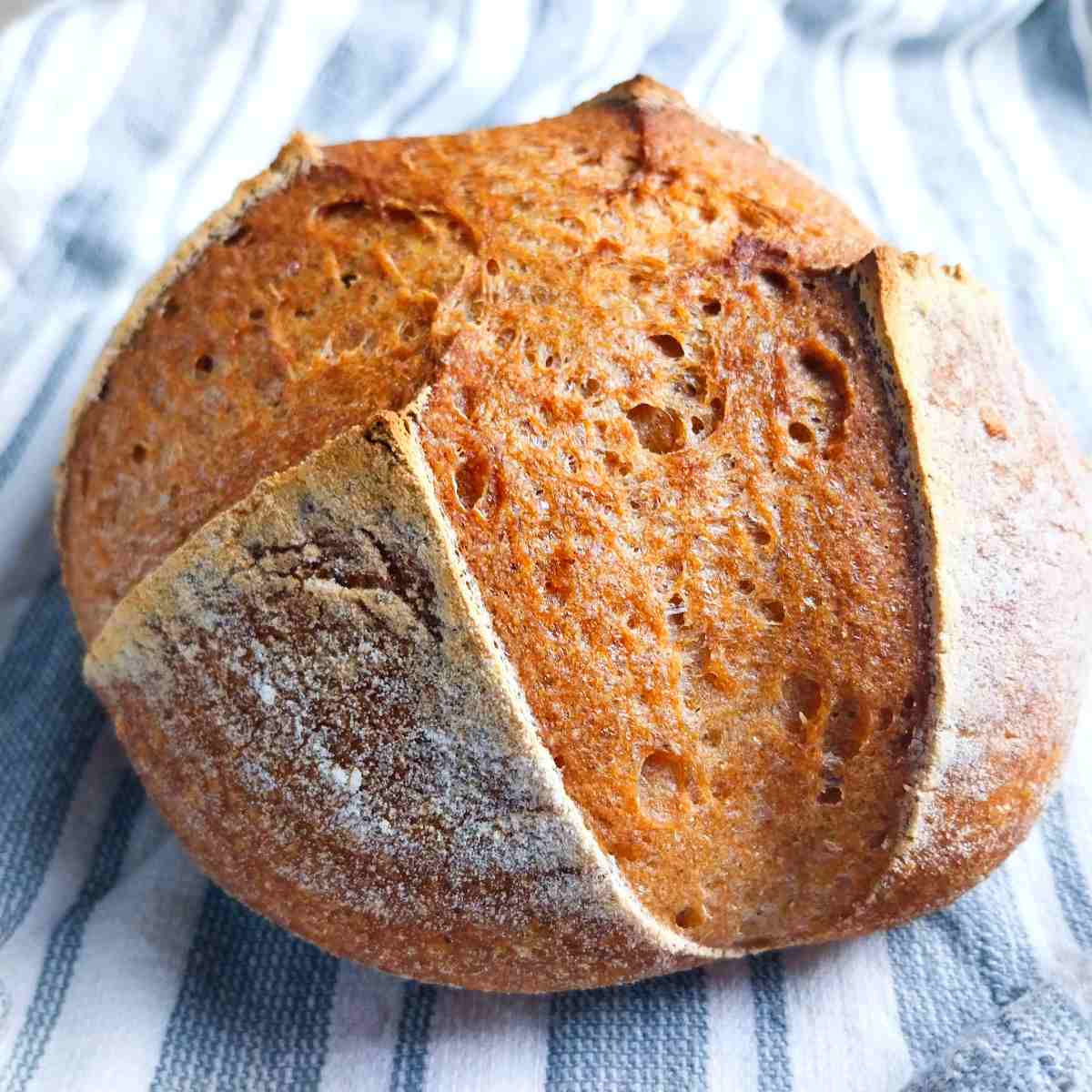
Jump to:
- Sourdough vs. Commercial Yeast
- Gluten-Free Starter
- Psyllium Husk
- Sourdough Terminology Explained
- 🍽 Tools You Might Need
- The Best Flour for GF Sourdough
- A note on flour types
- Would rather watch?
- 🥘 Ingredients
- 📖 Substitutes
- 🔪 Step-by-step instructions
- Troubleshooting
- Frequently Asked Questions
- More Gluten-Free Sourdough Recipes to Try
- Get my GF sourdough recipes eBook
- 📖 Recipe
- 💬 Community
Sourdough vs. Commercial Yeast
Sourdough bread uses naturally grown yeast with wild bacteria that is naturally found in the air around us and in water and flour used to make a starter.
Commercial yeast is a single strain of bacteria created in a lab to speed up the fermentation process.
While commercial yeast is easier to use, sourdough will provide a unique flavor, more nutrients, and an authentic experience of artisan bread baking.
New to gluten-free sourdough? Watch my 16-minute video tutorial for beginners!
Gluten-Free Starter
You will need an active starter for this recipe, if you don't have a starter yet, make sure to read my minimal waste starter guide.
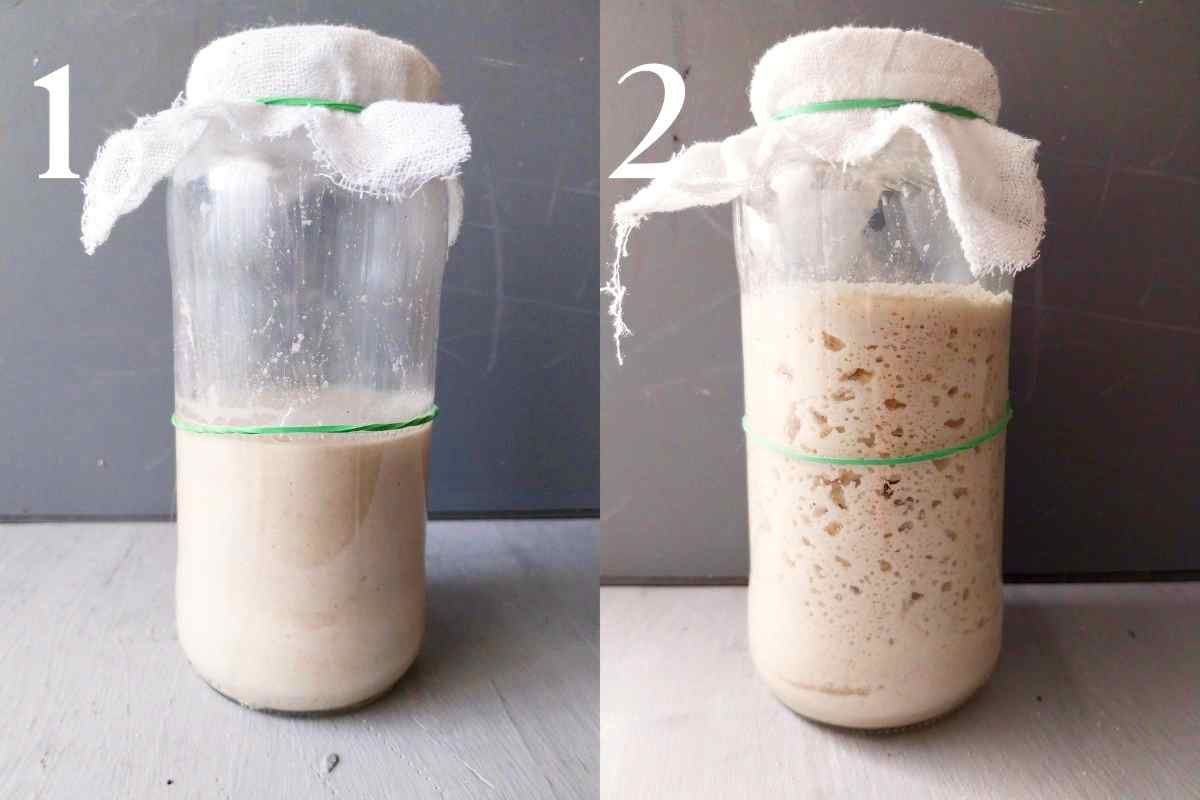
Psyllium Husk
While some recipes use xanthan gum, I prefer using psyllium husk as a binder in gluten-free sourdough bread. I wrote more on this wonderful ingredient in my psyllium 101 article!
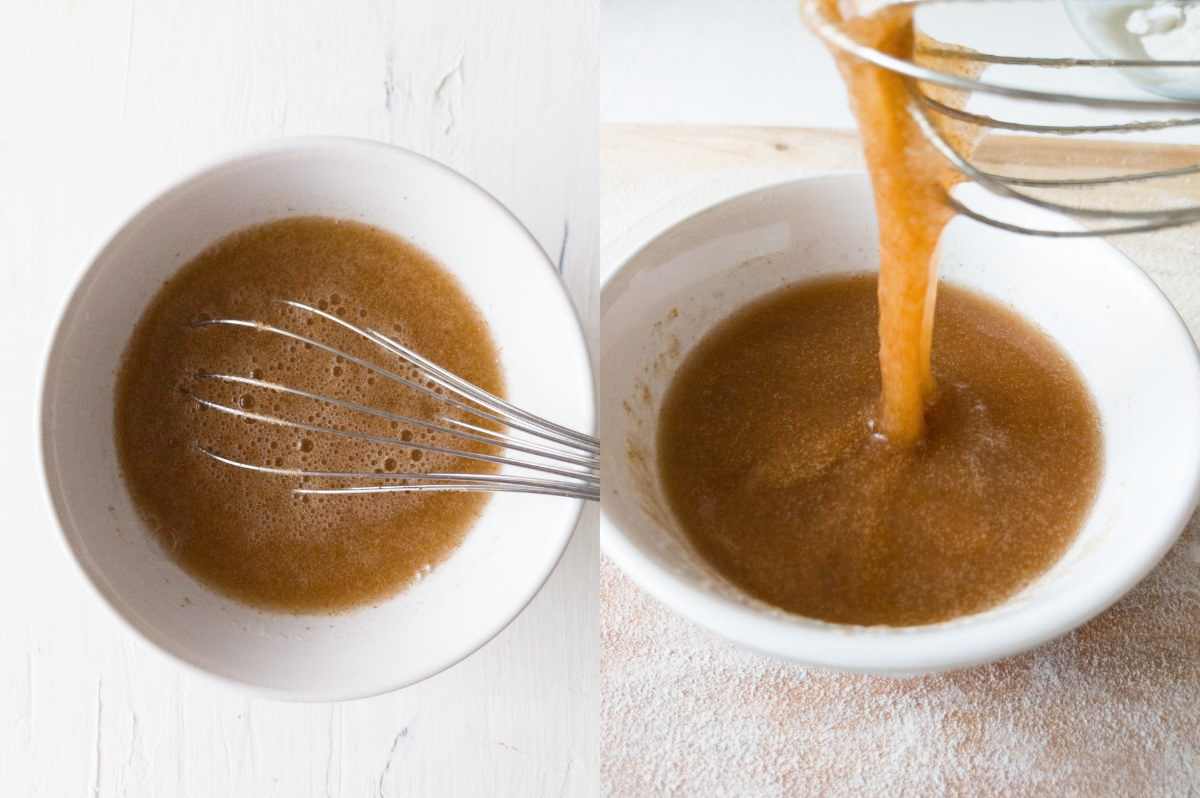
Sourdough Terminology Explained
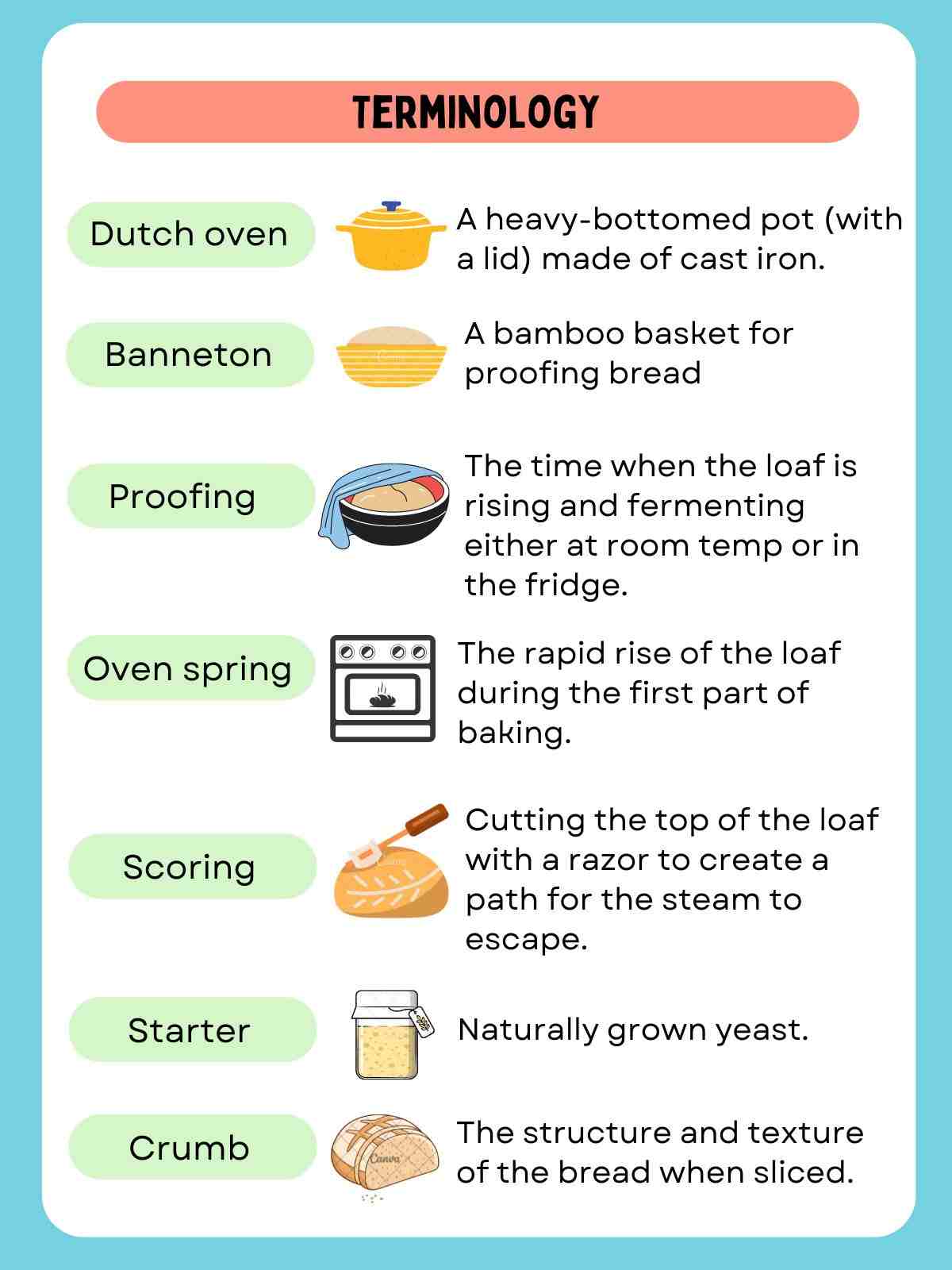
🍽 Tools You Might Need
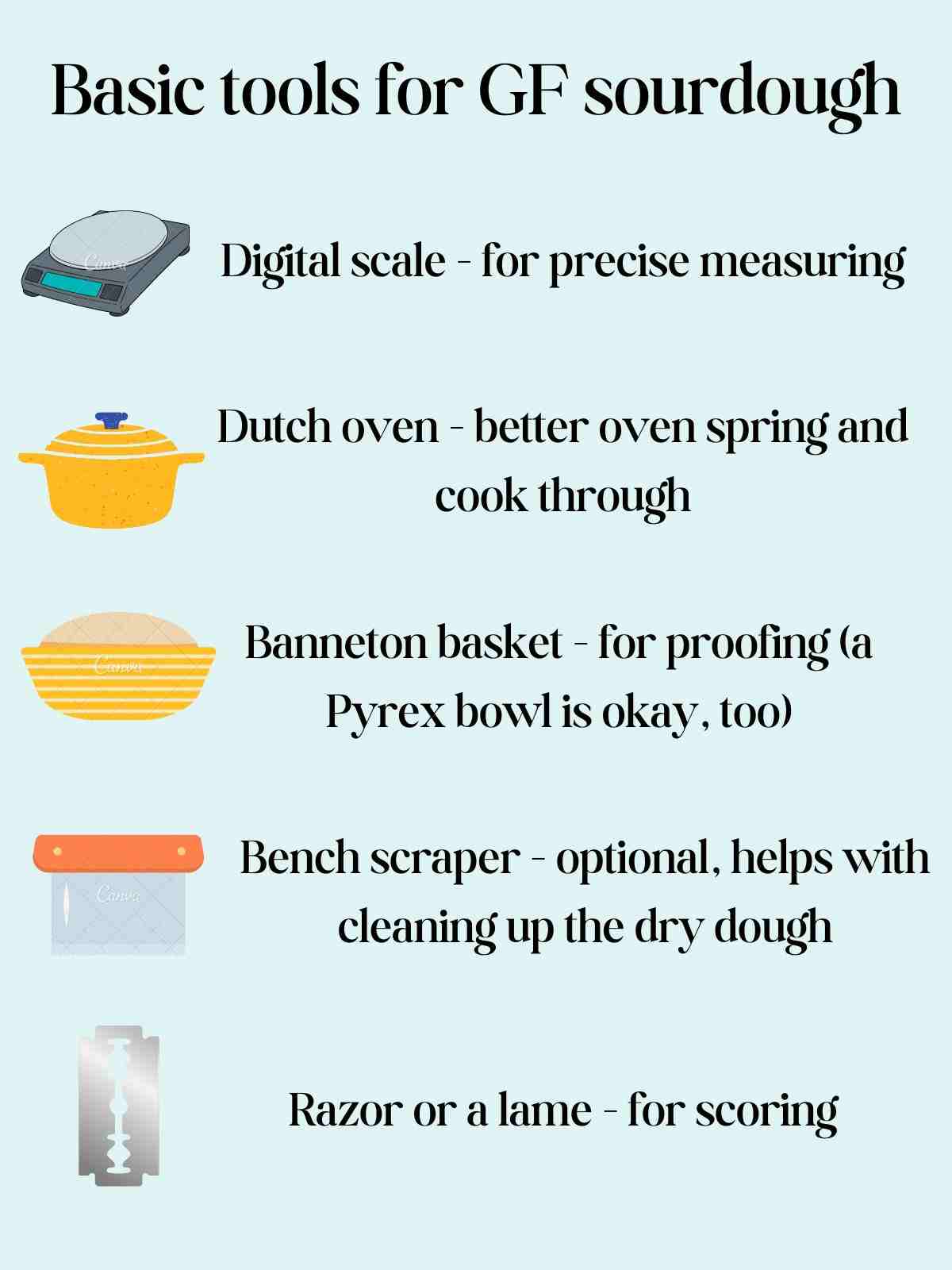
- A Dutch oven. You can also use a cast iron pan/baking sheet with a dish filled with water at the bottom to create extra steam during baking.
- A digital kitchen scale. I don't provide the cup measurements because it is so important for gluten-free sourdough to be measured by weight and not by volume!
- A banneton basket allows for a pretty pattern and better breathing of the dough. You can use a mixing bowl lined with a kitchen towel instead if you need to!
- A bench scraper. This tool is amazing when it comes to cleaning up the doughy mess off of the kitchen counter!
The Best Flour for GF Sourdough

Almond and coconut flours are not the best for making sourdough bread because of their low carb content. You can, however, add some starter to my almond bread recipe if you need a keto sourdough recipe!
A note on flour types
It is important to add starches like potato, corn, tapioca, or arrowroot to the dough for a fluffier crumb. If you can't have starches, check out my 100% millet, 100% sorghum, and 100% brown rice flour sourdough recipes.
Would rather watch?
Here is a quick 3-minute video of the whole process!
🥘 Ingredients
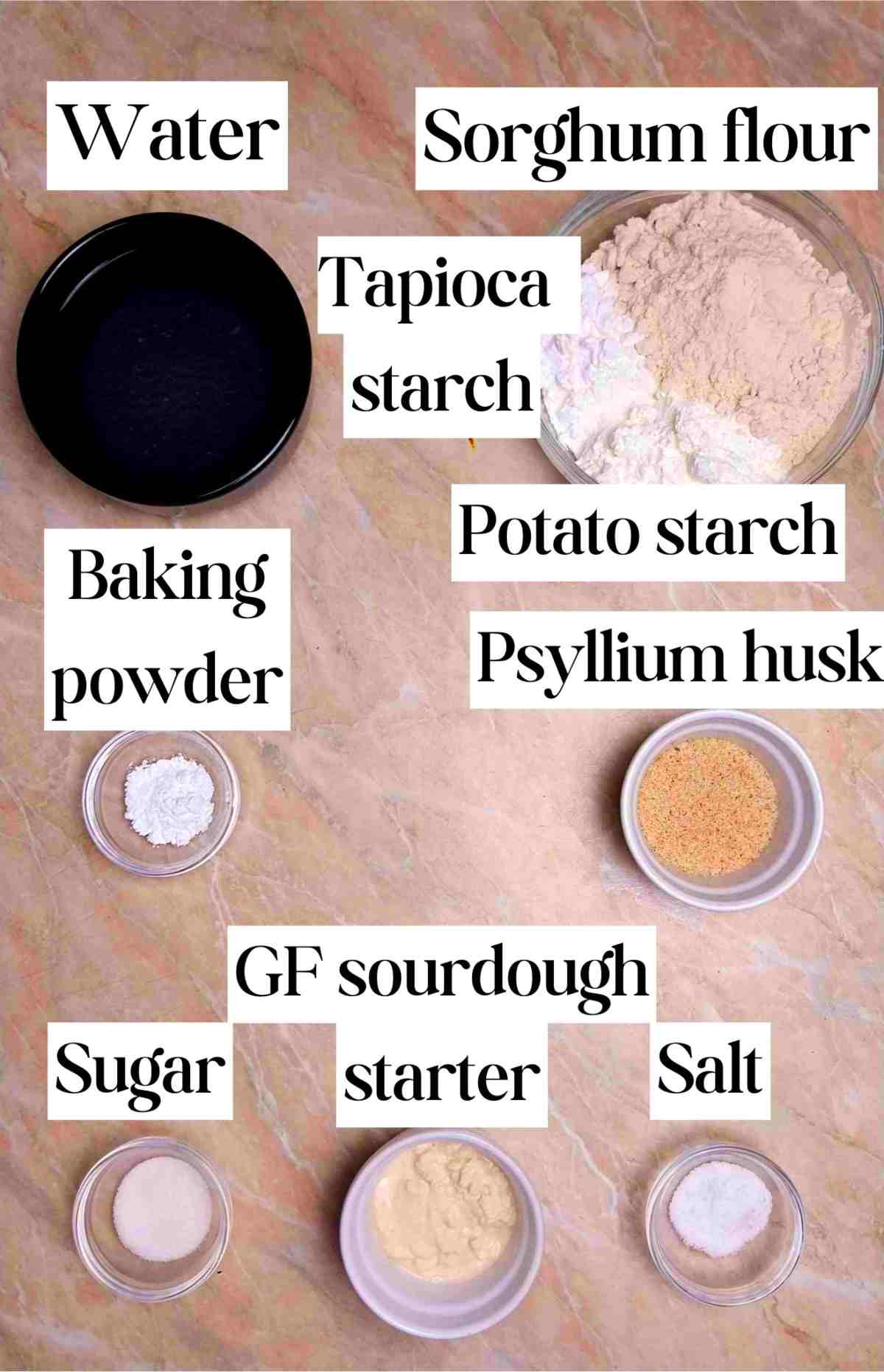
Gluten-free sourdough starter - use a mature starter that is at its peak activity, meaning when it is at its highest point of rising. Check out my gluten-free sourdough starter recipe if you don't have one!
Psyllium husk - you can use whole husks or powder. I prefer baking with whole husks as they are very easy to handle. But if you only have powder, then try avoiding very fine powder and opting for the coarser variety instead. For more information refer to my article about psyllium husk in baking.
Water - use room temperature water for the best results. I use tap water with no problems but if your tap water has chlorine in it, you will need to use filtered or bottled water.
Sorghum flour - European brands tend to be lighter than the US ones. You can use either sorghum flour, the results will be the same!
Starches - tapioca starch adds softness and chewiness to the texture while potato starch adds lightness to the loaf.
Baking powder - optional, but it helps raise the loaf and get more air in the bread.
Sugar - it is used for bacteria to feed on.
📖 Substitutes
Flour - feel free to experiment with other flour types keeping in mind that some of them might need more water than others!
Psyllium husk - I don't recommend substituting psyllium husk. You can use psyllium powder instead but keep in mind it might clump and/or turn your bread purple.
Sugar - use the same amount of maple syrup or honey in place of sugar.
🔪 Step-by-step instructions
Step 1
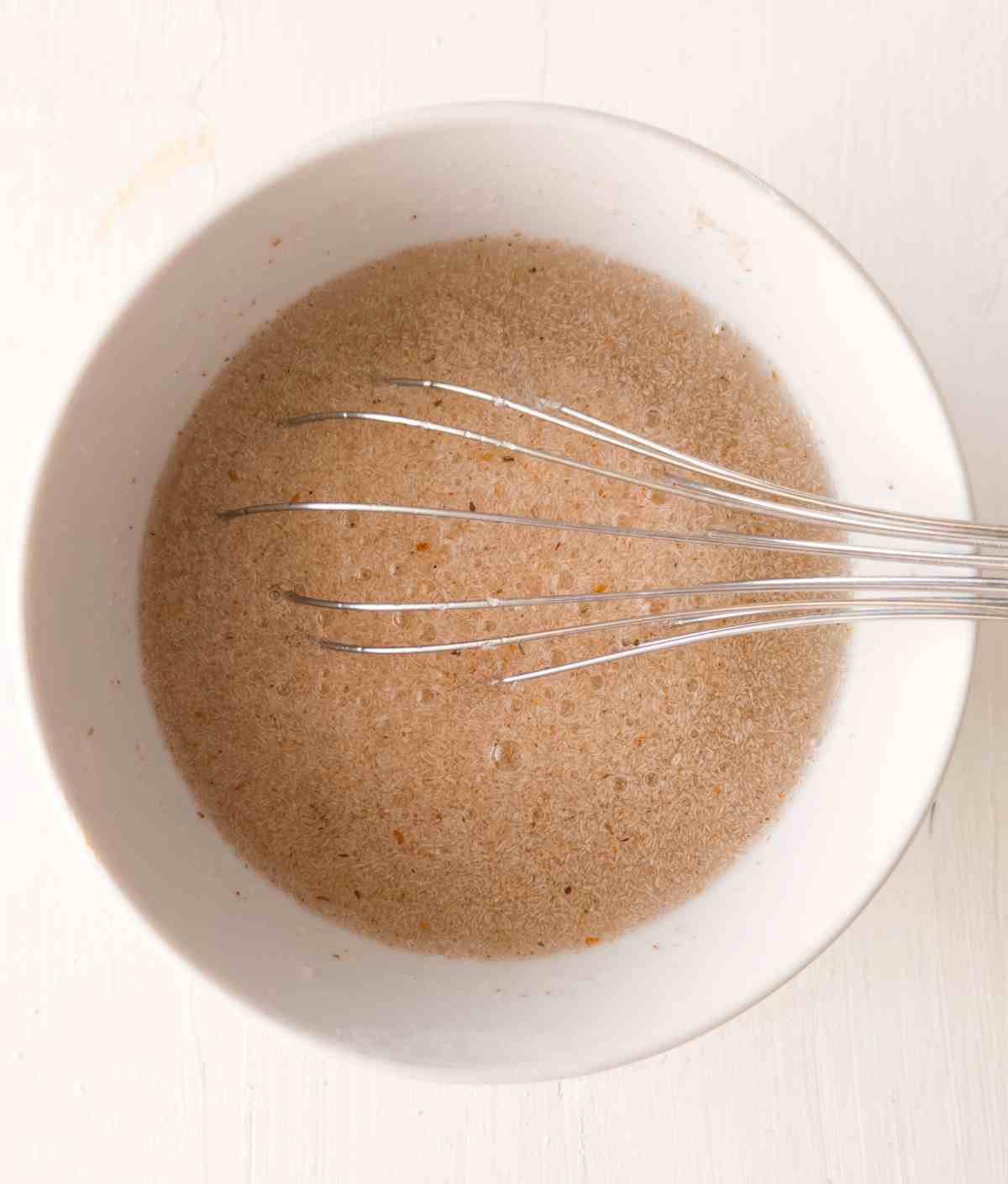
Combine psyllium husk, sugar, and room temperature/warm water in a medium-sized bowl, whisk to incorporate, and set aside.
Step 2
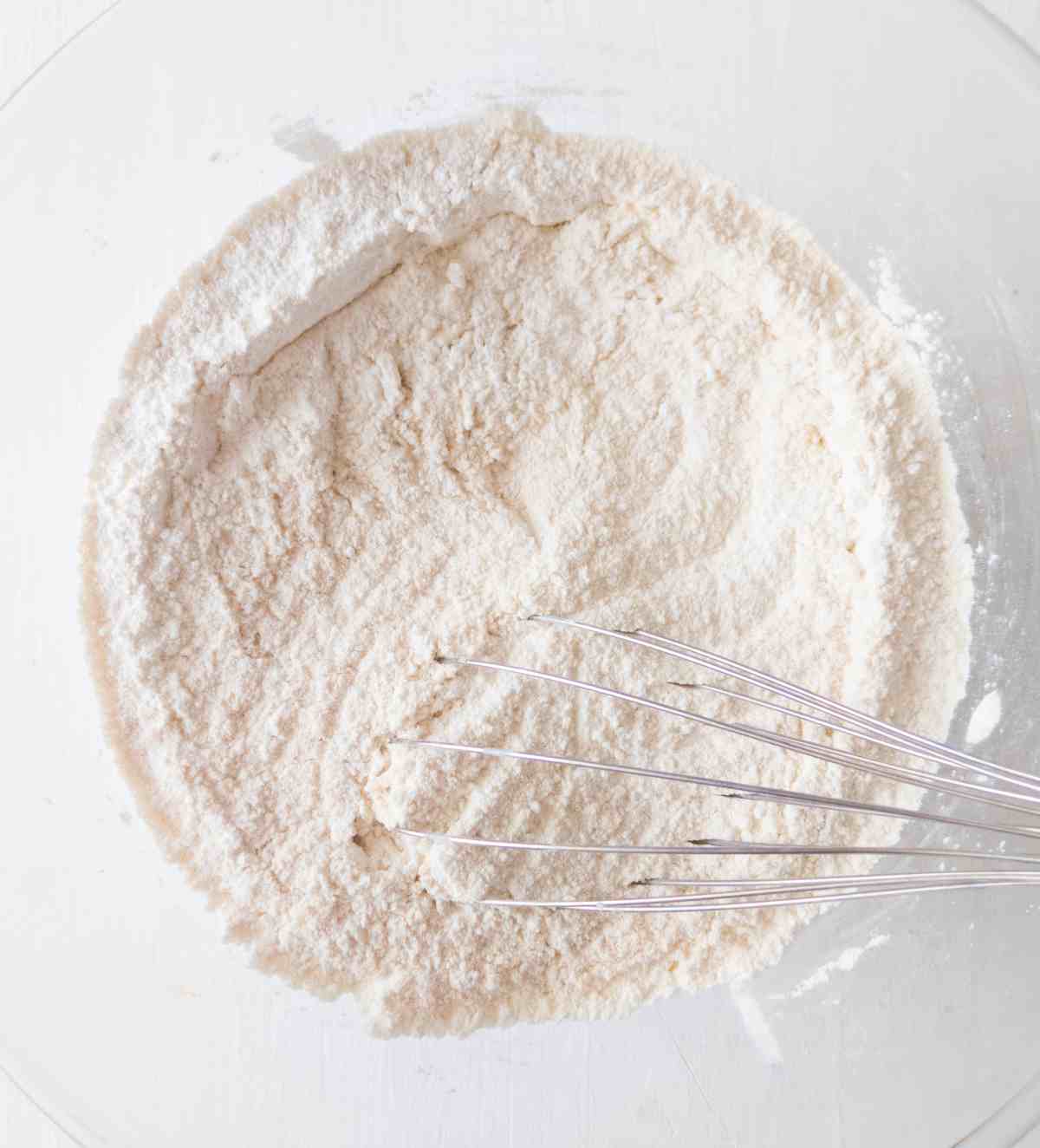
In a large mixing bowl combine all the dry ingredients (sorghum flour, starches, baking powder, and salt) and whisk to incorporate.
Step 3
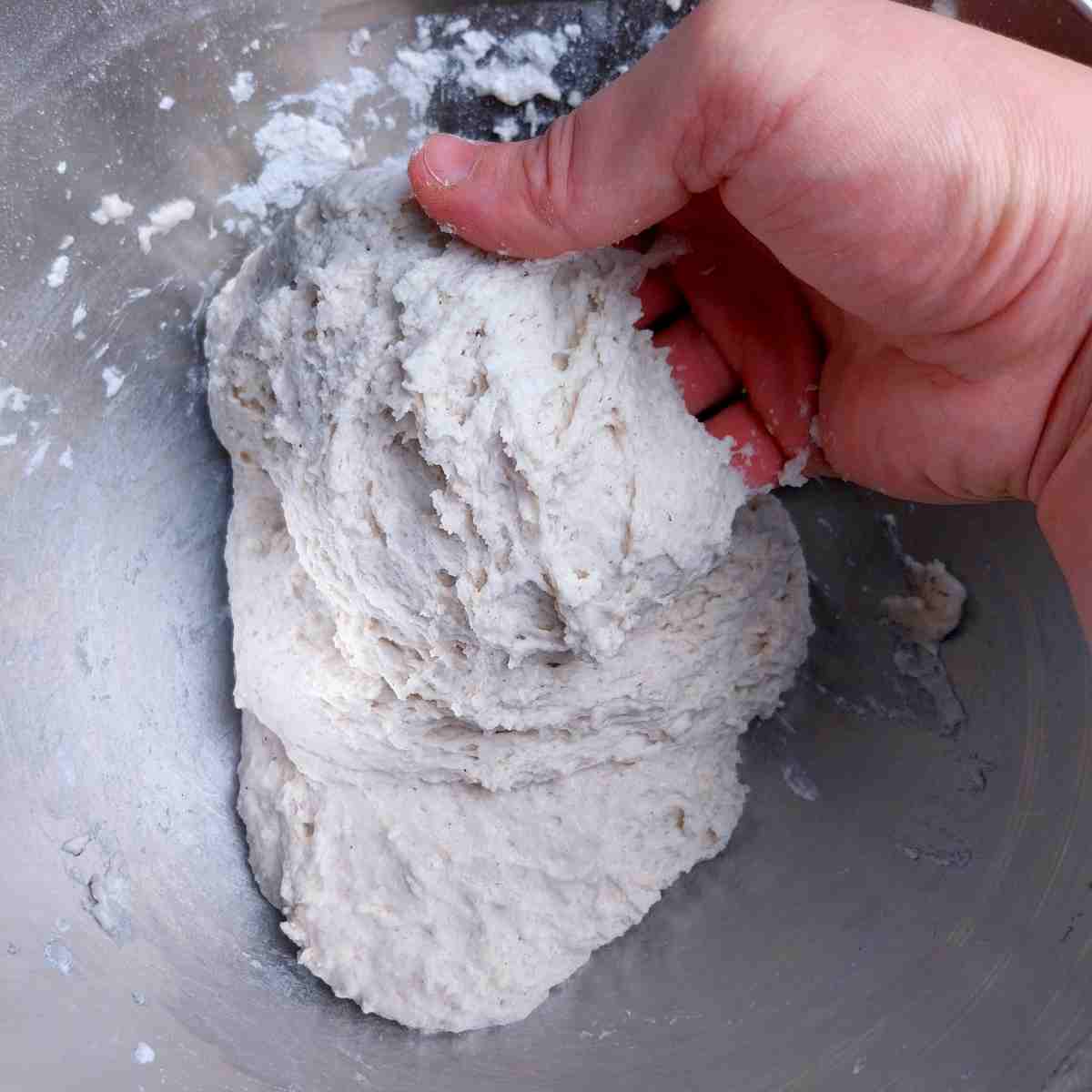
Once psyllium forms a gel, add it to the bowl with the dry ingredients.
Add mature gluten-free sourdough starter to the bowl and mix the dough thoroughly.
I like to use an electric mixer for this step but you can also do it by hand if you prefer.
Step 4
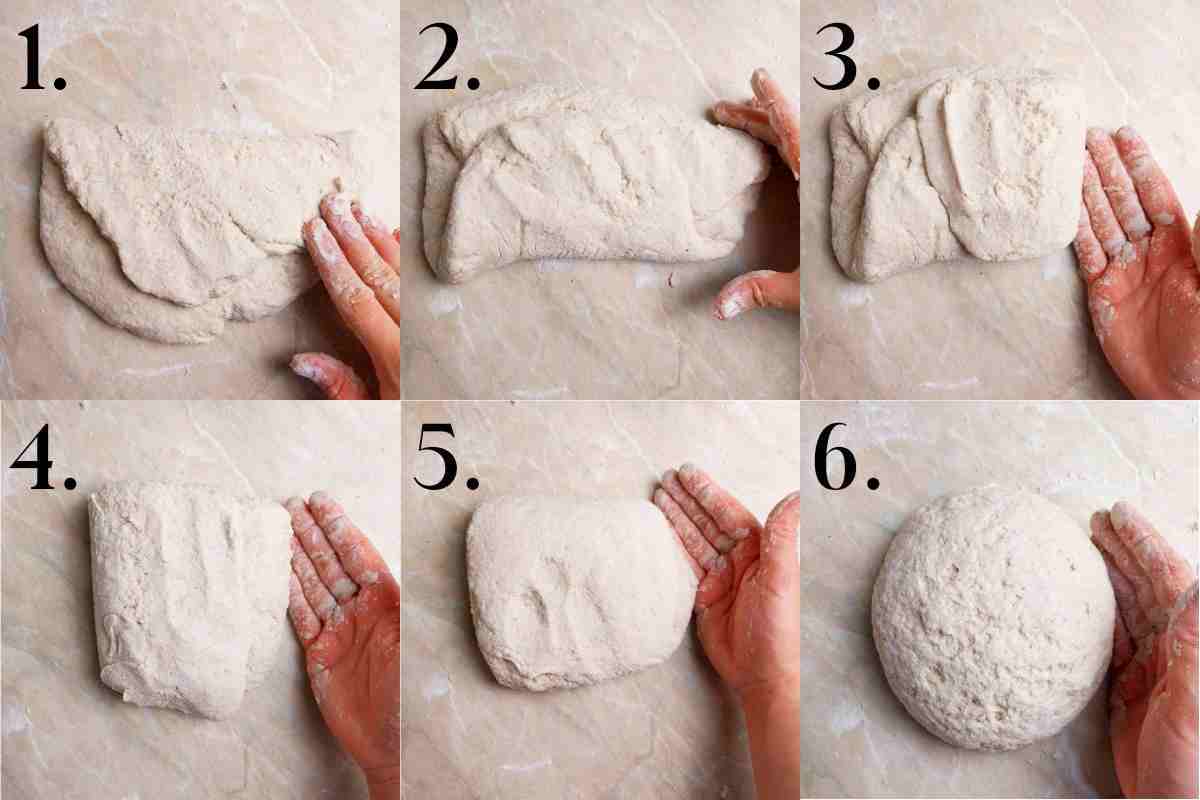
Once the dough is well incorporated, turn it over onto a lightly floured working surface and flatten it into a disc.
Fold each side of the disc onto its middle, flip the dough, and shape it into a ball (refer to the pictures for visual instructions).
Step 5
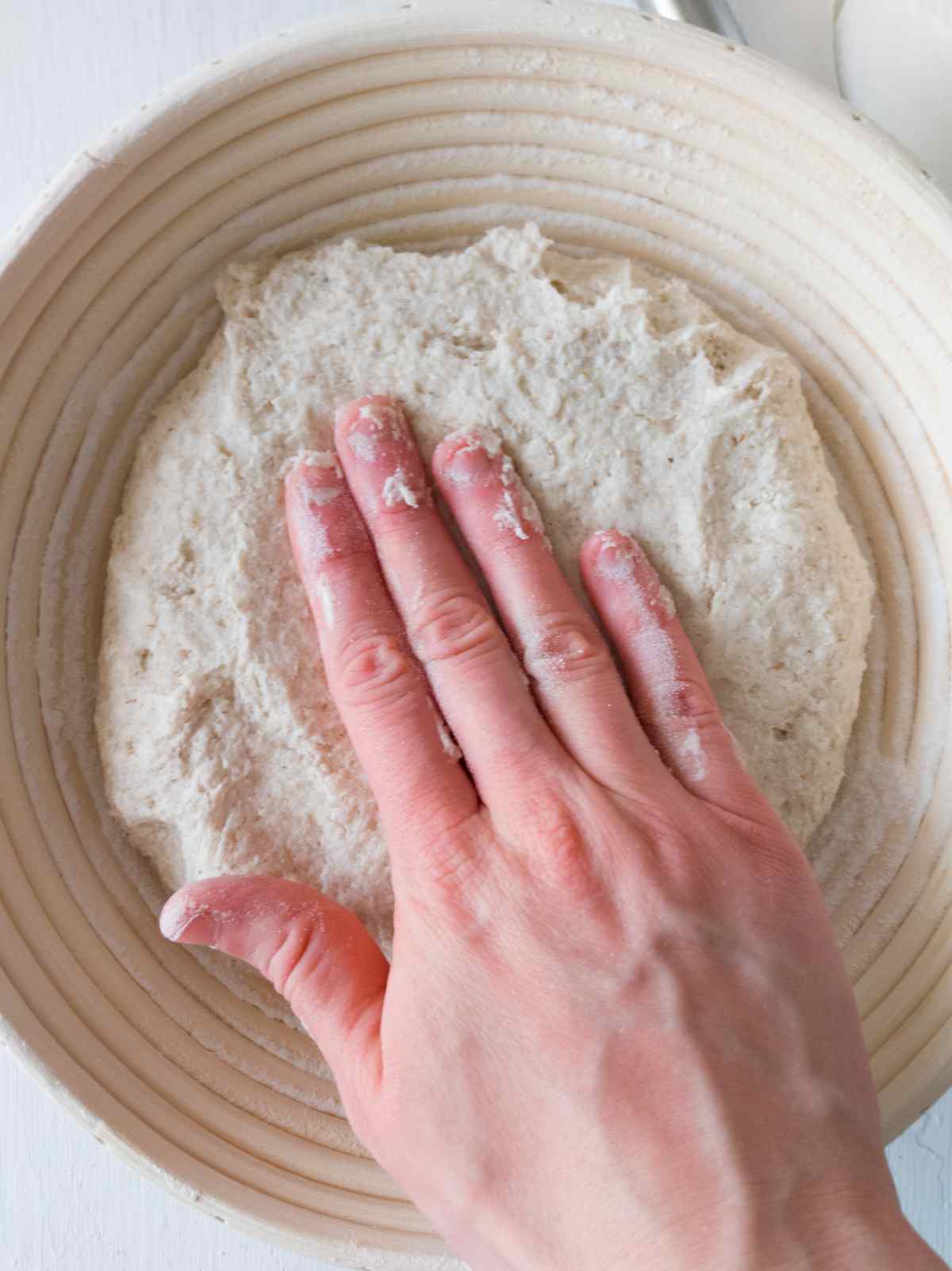
Flour the proofing basket or bowl lined with a kitchen towel and place the dough in it. Press the dough into the basket to create a flat top.
Cover the basket with a kitchen towel and leave to rise at room temperature for about 5 hours or in the refrigerator overnight (12-18 hours).
The dough should puff up during rising but it won't double in size. Don't worry if the dough doesn't rise a whole lot, it will do most of its job in the oven.
Step 6
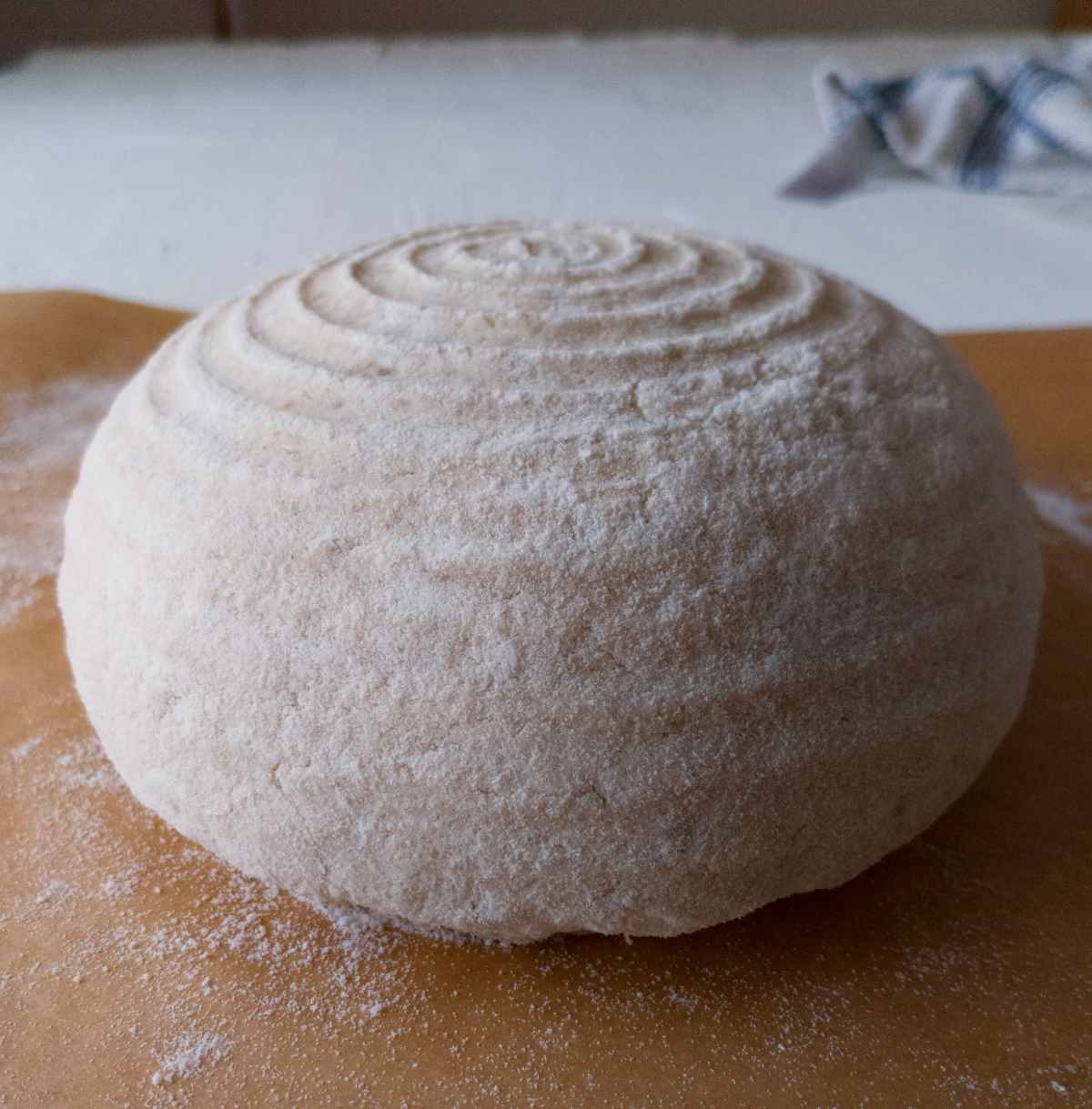
Once the dough has been proofed, gently turn it over onto the working surface.
Carefully shape the dough into a tighter ball by turning the dough around and tucking its sides under itself.
Don't push the dough too hard to avoid losing the air bubbles formed during fermentation.
Step 7
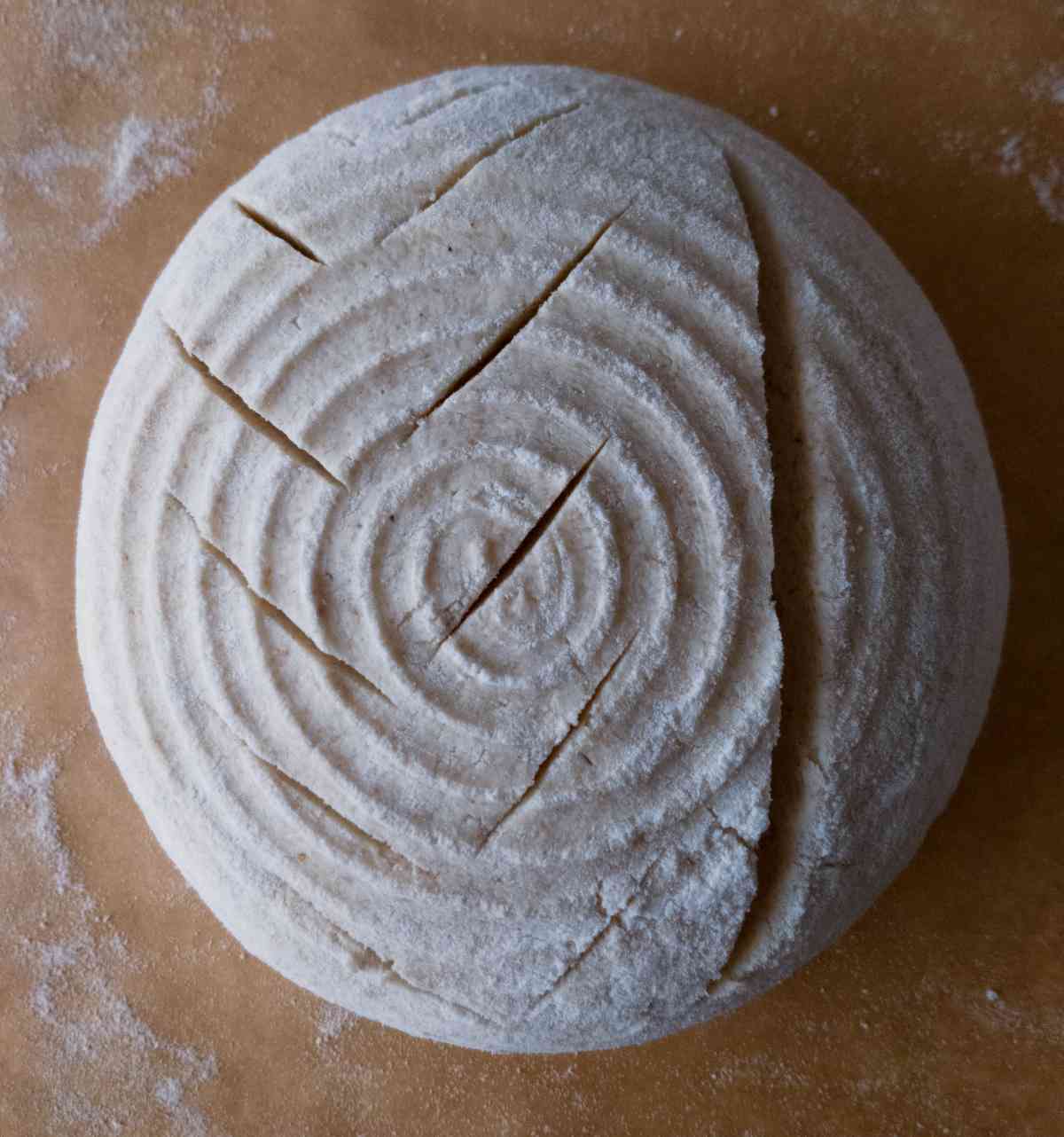
Score the dough with a razor, a lame, or a sharp knife (be creative and make a nice pattern!). Scoring allows for a better oven spring.
Transfer the dough onto a piece of parchment paper and gently lower it into the cold Dutch oven.
Place the Dutch oven with the bread into the oven and start preheating it to 450F/230C. Once the dough is heated, bake for 40 minutes with the lid on.
Then, take the lid off and bake for another 30 minutes.
Transfer the bread onto a cooling rack and wait until it is no longer warm to the touch to slice it. Enjoy!
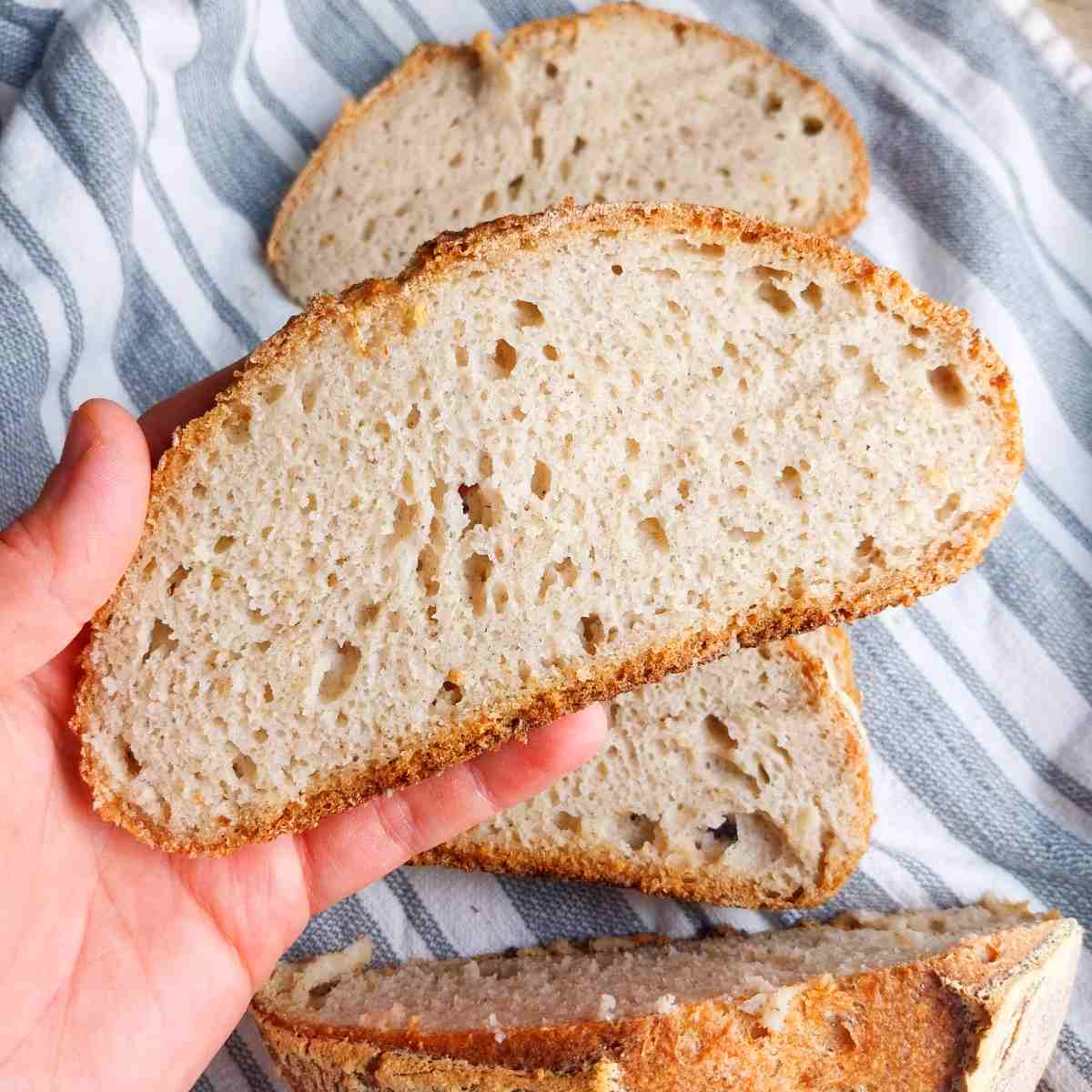
Troubleshooting
Gumminess - if your bread is gummy it might be due to underproofing/overproofing or not baking long enough. If you used other flour types than indicated in the recipe, you might need to adjust the water amount next time.
Too dense - if the bread doesn't have any bubbles and seems way too dense it could be due to a starter that isn't active enough or the cold proofing temperature.
A large hole in between the top crust and the crumb - this is a sign of overproofing the dough. Bake the dough sooner next time!
Frequently Asked Questions
Yes! Gluten-free starters won't always double and depending on the consistency, it might rise very little. You can still use it in bread as long as it is at least 2 weeks old!
You can give it a try but your bread might turn out gummier/drier depending on the contents of that flour blend.
More Gluten-Free Sourdough Recipes to Try
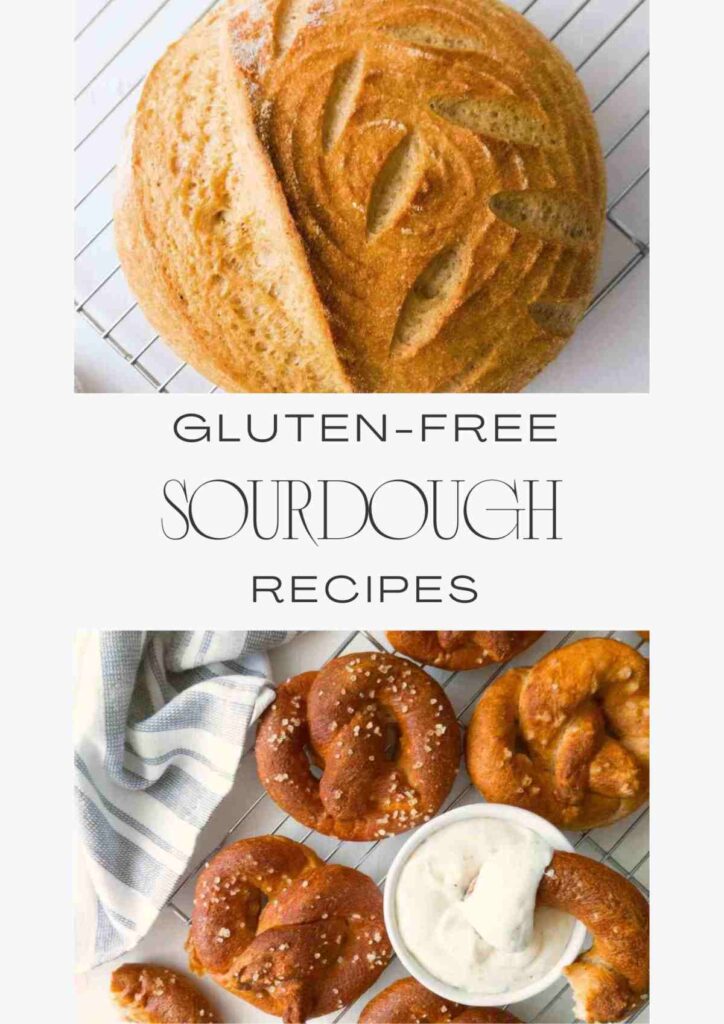
Get my GF sourdough recipes eBook
The top 16 recipes of 2024!
📖 Recipe
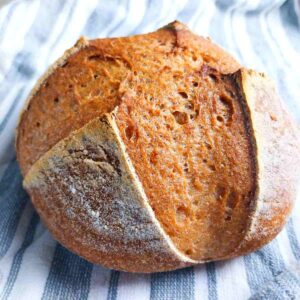
Gluten Free Vegan Sourdough Bread
Ingredients
Wet ingredients
- 20 grams (3 tbsp) psyllium husk, whole husks, if using coarse powder use 20 grams, fine powder - 17g. For more details check my psyllium husk 101 article
- 410 grams (1⅔ cups) water, room-temperature
- 15 grams (1tbsp + 1tsp) sugar/maple syrup, helps the sourdough bacteria
- 70 grams (¼ cup) active sourdough starter
Dry ingredients
- 85 grams (¾ cup) tapioca starch or arrowroot starch
- 95 grams (½cup + 1tbsp) potato starch or 95g (¾ cup) cornstarch
- 180 grams (1⅓ cups) sorghum flour
- 12 grams (2 tsp) salt
- 2 teaspoon baking powder, check the package to make sure it is gluten-free
Instructions
- Combine psyllium husk, sugar, and room temperature/warm water in a medium-sized bowl, whisk to incorporate, and set aside.
- In a large mixing bowl combine all the dry ingredients (sorghum flour, starches, baking powder, and salt) and whisk to incorporate.
- Once psyllium forms a gel, add it to the bowl with the dry ingredients.Add mature gluten-free sourdough starter to the bowl and mix the dough thoroughly.I like to use an electric mixer for this step but you can also do it by hand if you prefer.
- Once the dough is well incorporated, turn it over onto a lightly floured working surface and flatten it into a disc.Fold each side of the disc onto its middle, flip the dough, and shape it into a ball (refer to the pictures in the post for visual instructions).
- Flour the proofing basket or bowl lined with a kitchen towel and place the dough in it. Press the dough into the basket to create a flat top.Cover the basket with a kitchen towel and leave to rise at room temperature for about 5 hours or in the refrigerator overnight (12-18 hours).The dough should puff up during rising but it won't double in size. Don't worry if the dough doesn't rise a whole lot, it will do most of its job in the oven.
- Once the dough has been proofed, gently turn it over onto the working surface.Carefully shape the dough into a tighter ball by turning the dough around and tucking its sides under itself.Don't push the dough too hard to avoid losing the air bubbles formed during fermentation.
- Score the dough with a razor, a lame, or a sharp knife (be creative and make a nice pattern!). Scoring allows for a better oven spring.Transfer the dough onto a piece of parchment paper and gently lower it into the cold Dutch oven and put the lid on.Place the Dutch oven with the bread into the oven and start preheating it to 450F/230C. Once the oven is heated, simply bake for 40 minutes without opening the oven.Then, open the oven, take the lid off, and transfer the loaf onto the oven rack. Bake for another 30 minutes.Transfer the bread onto a cooling rack and wait until it is no longer warm to the touch to slice it. Enjoy!*If the bottom of your bread tends to burn, place a baking sheet in the bottom of the oven once you take the bread out of the Dutch oven.


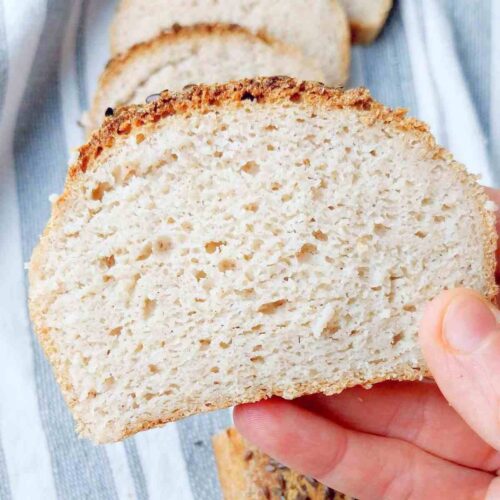
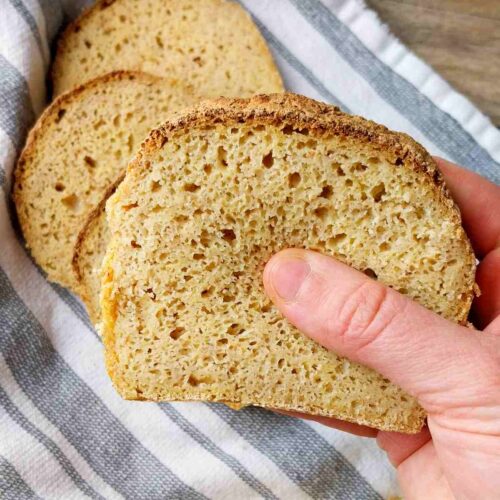
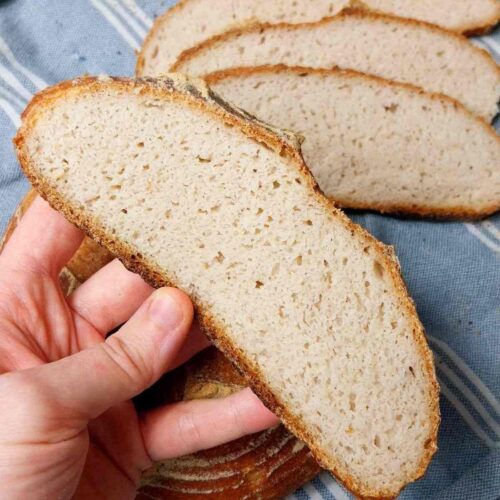
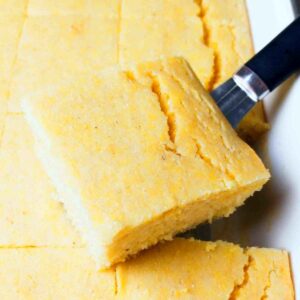

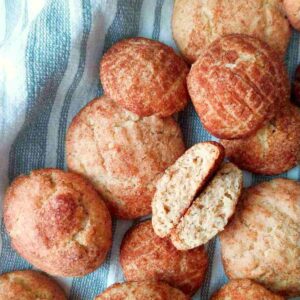

Maria Khan
Sourdough Bread looks great
Natashashome
Thank you!
Randi
I love this bread and am so happy I found this website! This is my 2nd time baking this. I think I might’ve gone overboard yesterday though- baking this bread, the sourdough buckwheat bread and the sourdough banana muffins all in the same day!
Now I need to try to not eat them too quickly!
Natasha Levai
Yay! Thank you so much for your feedback, Randi!
Kylene
Do you use a recently fed or unfed starter?
Can I use my starter if it already fell?
Natasha Levai
You can use a starter that has been fed at least 3-4 hours ago. It is ok if it already fell, that is not a problem. It is best to use it at its peak but that doesn't mean you won't get great bread with a starter that already fell or even was fed 24 hours ago and fell a long time ago. I made bread with all kinds of starters and it worked! The only starter I would not recommend is the one right out of the fridge.
Kylene
Excellent! I ended up feeding my starter right after I posted. Now it's time to try your recipe for the first time!
Thank you for posting! I'll let you know how it goes.
Courtney Lynn
Right now I am letting the levain sit. On the next steps under "preparing the dough", step 1 says mix psyllium husk etc, do I mix these into the levain bowl? Seperate bowl? Then mix levain, wet mix, and dry mix together at the end step of preparing the dough? I don't wanna mess this up!
Natasha Levai
Hi Courtney! It is best to mix everything separately. Let the levain sit and do its work, once it is ready, mix the psyllium gel in a separate bowl. Mixing psyllium husk with levain will make the formation of the gel much slower.
Lisa
Can I use tapioca flour instead of tapioca strarch?
Natasha Levai
Hi Lisa! Tapioca flour and tapioca starch are essentially the same thing, so, yes, you can use them interchangeably. 🙂
Christy
I have tried numerous loaves of gluten free sourdough since I started my sourdough journey. This one is the best so far. Whole family loved it and it came out fantastic. I am still working on how to not burn the exterior crust. So we are baking at 440 today. Because I think I’m realizing thanks to your post that my oven runs hot. Also my Dutch oven is cast iron, so I wonder if that gets hotter than a ceramic one as well. Every new loaf is a learning experience. Thank you for this bread.
Natasha Levai
Hi Christy! Thank you so much for your feedback. I find that if I take my bread out of the Dutch oven after the first 40 minutes and continue baking it on the rack then it doesn't burn most of the times. I am also using a cast iron Dutch oven! Lowering the temperature might also be a good idea. Hope you find what works for you!
Jane Manich
Hi Natasha❤️ I’m an newbie and am very close to making your GF sourdough bread. after proofing over night in the refrigerator, do I bake directly from the refrigerator, placing the scored bread into the preheated cast iron Dutch oven? Or do I let the dough warm up in proofing box a bit?
Thank you for all you do for this community
Jane
Natasha Levai
Hi Jane! There is no need to in warming it up, so you can bake straight from the fridge!
Tam Lee
if I proof overnight in the fridge do I skip the room temperature proofing?
Natasha Levai
You can! Although I find that my bread proofs better at room temperature.
Angie
I can't do corn or potato starch, any suggestions? Would more tapioca or arrowroot work?
Natasha Levai
Yes! You can substitute potato starch for any other starch (cornstarch, tapioca, arrowroot). The substitution is 1:1, so if the recipe calls for 100g potato starch, use 100g of any other starch of choice!
Lena
Hi Natasha!
I have a quick question. I’ve tried several different gluten free breads, and they all taste ok but are gummy. I understand that gluten free bread is more gummy, but was hoping to find a less gummy bread. Is your bread a bit gummy too? Thanks so much!
Natasha Levai
I am afraid, it can be a bit gummy. I have been trying to find the perfect balance between moist/not gummy but a lot of times it does turn out slightly gummy.
Lena
Thanks so much for responding so quickly! I’ll give your recipe a try as well and see how we like it 🙂
Illene
Has anyone let this proof in a loaf pan, skipped the final shaping, and baked it in the same loaf pan?
Natasha Levai
Yes, I tried baking it that way! It works just fine!
Katherine Britton
Awesome! How do you adjust the bake time for a loaf pan instead of a Dutch oven?
Natasha Levai
I recommend adding more water to the loaf, instead of 300g, add 400-450g and bake in the loaf pan for the same about of time. First stage 30 minutes and the second one 40 at a lower temperature!
Liene
Can I replace cornstarch/potato starch with just all tapioca starch?
Also do you recon it would work in bread machine setting 'bake' or air fryer regular setting? I know, I know it's not ideal just wondering if it's even worth the effort to try or will it be complete fail...
Natasha Levai
I don't recommend using a bread machine for multiple reasons! And yes, you can substitute the starches!
JJ
Have you experimented with konjac vs psyllium? If so what was your experience?
Natasha Levai
Hi JJ! No, I have not experimented with konjac as I have never seen it available in the stores where I buy my ingredients!
Stacie
I just got a millet starter up and running, do you think that will work for this recipe? I am also wondering what is the purpose of the sorghum flour, and is there a substitute for that you could recommend? I have quite a few flours and starches on hand but not that one. Thank you!
Chiara
I'm really excited to try this recipe. Your instructions say Millet Flour but your recipe says Sorghum flour and Millet flour is not mentioned in the recipe. Is it the same thing?
Natasha Levai
Hi Chiara! I switched to using sorghum flour because the results were much better than with millet! I probably forgot to edit it in all the places within the post, tank you for pointing it ou!
L
Thank you so much for this recipe! I have never done any sourdough baking before and this recipe was the first thing I've tried. It came out wonderful and the flavor and crust is delicious! My mom has several autoimmune issues and cant have gluten or commercial yeast so she hasn't had bread in years. She loves this bread and so do I. Thank you for helping me bring bread back in to her life! 😀
I'd also like to add that for anyone curious, I used tapioca and arrowroot starch instead of potato starch and it tastes great.
Natasha Levai
Hi Lena! I am so happy to hear your mom can eat bread again! Yay! Thank you for sharing this!
David Kouri
I was wondering if adding the olive oil at the same time as the psyllium husks are being hydrated would hinder their water absorption? I have been allowing the psyllium to gel then add the oil. What are your thoughts?
Natasha Levai
You are right that psyllium husk doesn't interact with oil the same way it does with water! So, if you want to, you can add it later, but I find that the amount of oil is insignificant to inhibit the formation of psyllium gel! So, I prefer to add them together because otherwise I tend to forget to add it at all. 🙂
Darlene
This is my first with GF sourdough bread. It looks beautiful. We will date when cooled! I am inspired by my daughter who is gluten intolerant! Excited that it came out this nice🌺
Natasha Levai
Excited for you, too!
Marcelle Blaauw
Oms I love this bread recipe, I love all your posts and recipes, you are in fact an angel send to help us better our baking!!
I have made this bread 3 times already and am addicted! I keep a slices frozen for a quick lunch.
One question though, can one add like cheese or peppers or so to the dough pre-bake?
Natasha Levai
I am so happy you are enjoying the bread! Yes, you can add the cheese and peppers to the unbaked dough!
Rachel
Thanks for the recipe!
Can this recipe be made in a slowcooker?
Natasha Levai
Hi Rachel! Unfortunately, this recipe is not good for a slow cooker!
Mary
Hi Natasha, do you instructions for this recipe to bake in a loaf tin rather than Dutch oven? I don't have a Dutch oven but would like to try the recipe.
Thanks Mary
Adrienne Steinbach
Hi can I use white vinegar or is apple cider the way to go ? Cannot wait to try this recipe!!
Adrienne
Natasha Levai
Yes, absolutely!
Rebecca
Everything is going as planned and after 12 hours in the fridge, the bread is still the same. No indentation when I press my finger in the cold dough. Can I take the bread out of the fridge and try to ferment on the counter?
Natasha Levai
Yes, let it sit at room temperature and see if anything changes. The bread should rise some before baking!
Tree
I made this for the first time over the weekend, my second sour dough bread. It ate was a big hit in my house! My 12yr old would "sneak" slices of it!
I already had my starter ready, I just used 100 grams of that, is that OK? should I use more? I wasn't sure exactly how much to add. Thank you! We're trying the pretzels today!
Natasha Levai
If you are using starter instead of making levain, then you need to use 300g of starter!
Karen
This came out delicious! Thank you so very much.
Question: Do you think I could trade out rice flour and sub buckwheat flour for the dough part? I have a brown rice starter and would still use the brown rice flour for the levain. Thank you.
Natasha Levai
I think you should be able to use buckwheat instead of rice flour with no problem!
Gail H
So you have a recipe using 1 to 1 flour? I would love to try that if you do.
Thank you !
Natasha Levai
Hi Gali! I don't normally use 1 to 1 flour, so as of right now I don't have a recipe for that. What 1 to 1 flour are you interested in?
Josh
My loaf is turning ok ok, not too gummy compared to 1:1 recipes. However I'm having a hard time hitting 210F without burning the bottom. Top looks great covering with foil but the bottom burns when cooking for the 60 min outside the dutch oven. Less time and the loaf is only at 180F. Any suggestions how to get inside temp up without burning the bottom.
Natasha Levai
Hi Josh! First, I'd recommend to reduce your first baking part in the Dutch oven to 30 minutes, then after the first part is done, take the bread out of the Dutch oven and place it onto the oven rack for the remainder of the time. Place the oven rack higher up so that it isn't as close to the bottom source of heat. At the same time, place the baking sheet in the bottom of the oven to prevent to limit the heat a little bit.
See if that helps!
Carole Biro
Do you have a recipe for keto sourdough. I haven’t eaten carbs for years which keeps my weight down.
Natasha Levai
I don't have a specifically keto sourdough recipe but you can add some of the starter discard to this keto gluten-free almond bread: https://www.natashashome.com/low-carb-gluten-free-bread/
Cheryl Lee Pokorny
First, don't jump to recipe. Just to make sure you know how important this is: DON'T JUMP TO RECIPE!! Natasha gives so many tips before the recipe that are super helpful! Also, why you are waiting for your starter to peak, check out her whole site. Baking gluten-free sourdough is not easy but we can draw on the experience of others who went before us in this adventure. I baked 3 doorstops before I successfully baked this loaf. I did not read all the notes and tips or my loaf would have been even better I'm sure. I was using Bob's Red Mill Gluten Free 1:1 in my previous attempts and the bread was super gummy due to the xanthan gum it that flour mix. I saw Natasha's note about this so I changed my flour not to include the xanthan gum and the bread has such a better texture. I'm going to order her Sourdough e-book now as this was the 2nd recipe of hers that succeeded (check out her cinnamon rolls-yummy).
supriya pokhariyal
hi if we are baking this in loaf tin do we need to create steam in oven for first 30 min
Natasha Levai
Yes!
Mandi
Isn’t possible to use all rice flour? I don’t have the Sorgum flour. I do have almond flour if I can substitute that in its place? Or all rice flour
Natasha Levai
You can use all brown rice flour if you prefer, it will yield a denser loaf but it is possible to make! I have a recipe for brown rice flour only here https://www.natashashome.com/brown-rice-sourdough/
I don't recommend using all white rice flour for this recipe as white rice flour will create a gritty and dense loaf that won't ferment properly.
Wendy Taylor
Questions: what is supposed to occur during proofing b/c my dough looks exactly the same (quite dense) when it comes out of the refrigerator? Is it suppose to be rising? Am I doing something wrong? Thx!
Wendy Taylor
My starter that I use in the recipe rises beautifully so I’m not sure if I should be doing something differently to get the dough to expand during proofing. Thx!
Natasha Levai
Is your dough on the drier side? You might need to increase the water in the recipe to see a better rise. Also, it is a good idea to proof the dough in a warm spot.
Natasha Levai
It should be rising, it won't double in size, but it will puff up. If it didn't puff up during proofing, the bread will be dense! I would try proofing at room temperature or even better, in the oven with the light turned on. This will provide the best conditions for the bacteria to thrive.
Janet
I Ve been baking from a printed copy for this bread; keeping notes on what I tweak. Looking at the recipe on the website, I see you’ve made some changes. The increased water in the levain, a range of water in the recipe and in the flours. (I was already using brown rice and sorghum). I was curious about the changes in water especially in the levain. 20 more grams would definitely change the consistency. Why the changes and what should the consistency of levain be?
One other question , could this recipe be baked in a 8x4x4 Pullman?
Natasha Levai
Hi Janet! Yes, I kept tweaking this recipe for some time as I was getting more and more feedback from our Facebook group. I increased the levain water because I find that brown rice flour needs about 20g more water to be the right thick paste consistency in the levain instead of creating a chunky mix. Plus, I changed the amounts of flour and water in the recipe to create a smaller and a more balanced loaf! You can bake it in a Pullman pan but for that I would suggest adding even more water to the dough. It won't hold shape but it will do better at rising!
Kam
Hi Natasha!
I love this loaf. My favorite gf sourdough recipe I’ve found, by far. I was wondering if it’s possible to make a bigger loaf by 1.5x or doubling the recipe? Or would that cause it to not rise or cook through? Any tips for creating a bigger gf sourdough loaf?
Thank you!
Natasha Levai
Hi Kam! The reason the loaf is small is so that it rises better and cooks through well. If you increase the size of the loaf, your bread might be gummier and denser, but you can increase the recipe if you need to!
Ella
On my first attempt this is already my favorite gf sourdough recipe I’ve found! I don’t have sorghum so I replaced it with buckwheat which was perfect.